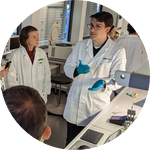Please wait...
About This Project
Multilayer Photolithography is a common technique that uses light to make 2.5D-3D structures. It is especially useful for fabricating very small microscale and even nanoscale things - e.g. computer chips, microscopic sensors, diagnostic tools for healthcare. Despite its popularity, the equipment needed for high resolution (<100um feature) multilayer photolithography (e.g. a "mask aligner") is prohibitively expensive ($60K-100K). This project seeks to make a DIY mask aligner kit for $1-2K.



